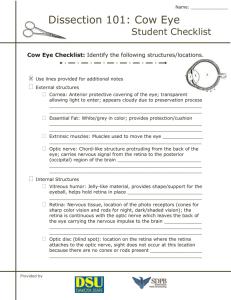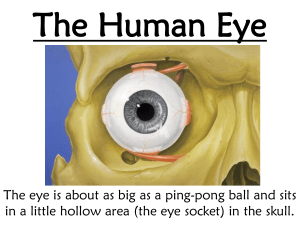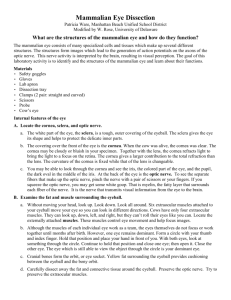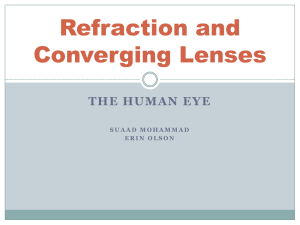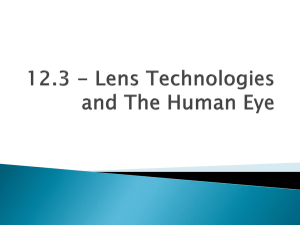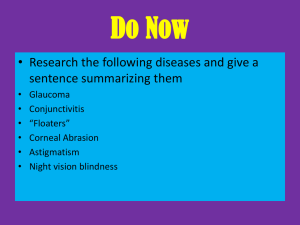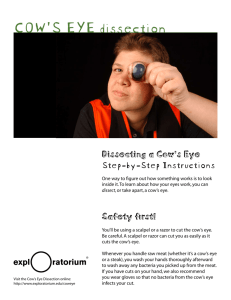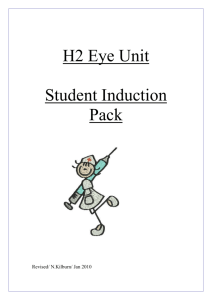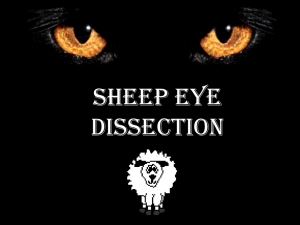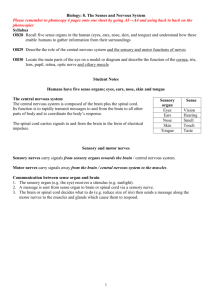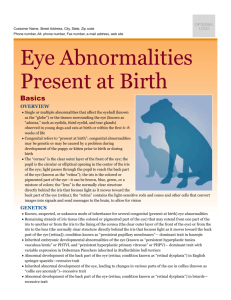Cow Eye Dissection Guide
advertisement
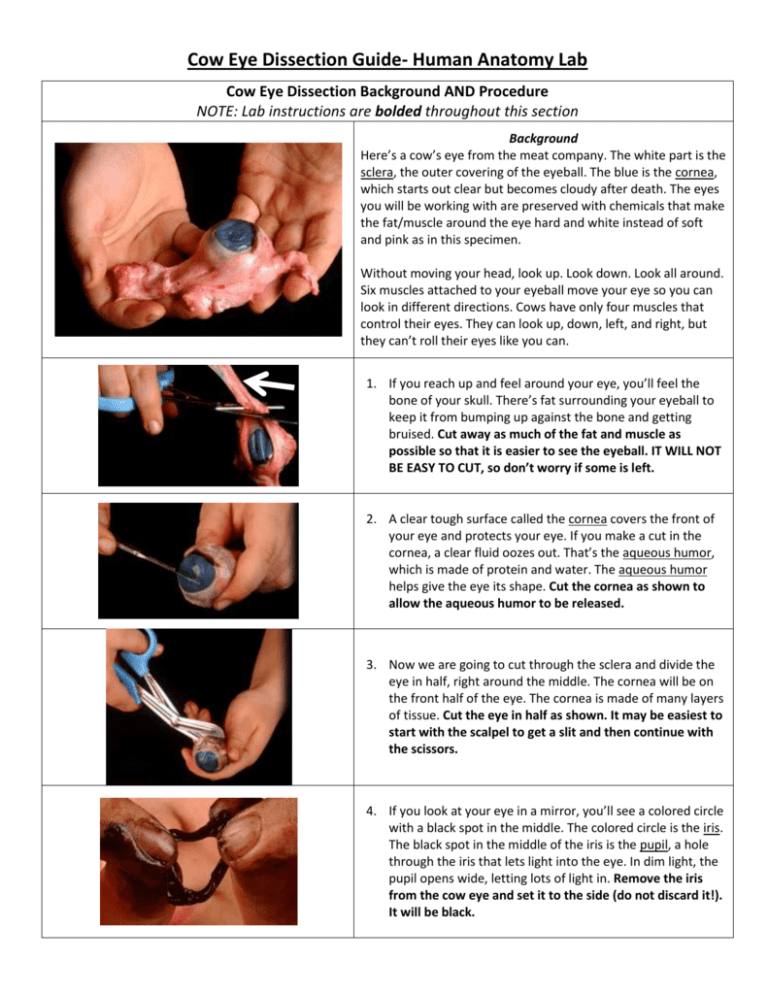
Cow Eye Dissection Guide- Human Anatomy Lab Cow Eye Dissection Background AND Procedure NOTE: Lab instructions are bolded throughout this section Background Here’s a cow’s eye from the meat company. The white part is the sclera, the outer covering of the eyeball. The blue is the cornea, which starts out clear but becomes cloudy after death. The eyes you will be working with are preserved with chemicals that make the fat/muscle around the eye hard and white instead of soft and pink as in this specimen. Without moving your head, look up. Look down. Look all around. Six muscles attached to your eyeball move your eye so you can look in different directions. Cows have only four muscles that control their eyes. They can look up, down, left, and right, but they can’t roll their eyes like you can. 1. If you reach up and feel around your eye, you’ll feel the bone of your skull. There’s fat surrounding your eyeball to keep it from bumping up against the bone and getting bruised. Cut away as much of the fat and muscle as possible so that it is easier to see the eyeball. IT WILL NOT BE EASY TO CUT, so don’t worry if some is left. 2. A clear tough surface called the cornea covers the front of your eye and protects your eye. If you make a cut in the cornea, a clear fluid oozes out. That’s the aqueous humor, which is made of protein and water. The aqueous humor helps give the eye its shape. Cut the cornea as shown to allow the aqueous humor to be released. 3. Now we are going to cut through the sclera and divide the eye in half, right around the middle. The cornea will be on the front half of the eye. The cornea is made of many layers of tissue. Cut the eye in half as shown. It may be easiest to start with the scalpel to get a slit and then continue with the scissors. 4. If you look at your eye in a mirror, you’ll see a colored circle with a black spot in the middle. The colored circle is the iris. The black spot in the middle of the iris is the pupil, a hole through the iris that lets light into the eye. In dim light, the pupil opens wide, letting lots of light in. Remove the iris from the cow eye and set it to the side (do not discard it!). It will be black. 5. Here is the back half of the eye. With the cornea and the iris out of the way, you can see the lens. It looks gray in this photo, but it’s really white in your specimen. The clear goo around the lens is the vitreous humor. The eyeball stays round because it’s filled with this clear goo. If the cow’s lens were not cloudy, if you looked though it, everything on the other side would look upside down and backward. Our lens is the same, but our brain flips everything around for us! The lens is also like a magnifying glass because it is thicker in the middle than it is at the edges. Remove the lens from the cow eye and set it to the side (do not discard it!). It will be white and hard. Dump out the vitreous humor. 6. Here’s the back of the eye with the lens and vitreous humor removed. It’s shaped like a bowl. On the inside of the bowl is a thin film with red blood vessels running through it; this is called the retina. The retina contains light-sensitive cells that detect light. The retina will be very hard to see in your specimen. Behind the retina is a layer of shiny, blue-green stuff called the tapetum. This layer assists night vision by reflecting light back through the retina. You don’t have a tapetum, but cats and cows (and other animals) do. A cat’s eyes shine in the headlights of a car because of the tapetum. Remove the tapetum. 7. The retina is attached to the back of the eye at just one spot. It’s called your blind spot. Because there are no lightsensitive cells at that spot, you can’t see anything that lands in that place on the retina. At the blind spot, all the nerves from the retina join to form the optic nerve. At the back of the eye, you can see the optic nerve, which carries messages from the retina to the brain. You see the world because your lens makes a picture on your retina, the retina sends a message to your brain, and your brain turns that message into a mental picture of the world! Find the optic nerve. 8. CALL THE TEACHER OVER FOT THE LAB QUIZ. a. There is no lab data for this dissection, only a lab QUIZ. b. Be sure that you did not discard ANY pieces of the cow’s eye. c. ALL MEMBERS of your group need to be able to point out and define all underlined words from these instructions. d. The teacher will ask each group member a question regarding these underlined words (which may include pointing it out on your cow eye). Only the person asked may answer. e. Points will be deducted from the group for talking out of turn or answering wrong. f. The teacher will also check your cow eye to make sure you dissected it properly- points will be deducted if it appears you did not follow instructions or if you behave inappropriately at any point during the lab. g. Be sure you are ready for this before you call the teacher over for the quiz!! Cow Eye Dissection Guide- Human Anatomy Lab Glossary Aqueous humor-A clear fluid that helps the cornea keep its rounded shape. Blind spot- The place where all nerves from the retina join to form the optic nerve. Each eye has a blind spot where there are no light-sensitive cells. Cones-One kind of light-sensitive cell in the retina. Cones give you color vision in bright light. Cornea- A tough, clear covering over the iris and the pupil that helps protect the eye. Light bends as it passes through the cornea. The cornea begins bending light to make an image; the lens finishes the job. Iris- A muscle that controls how much light enters the eye. It is suspended between the cornea and the lens. A cow’s iris is brown. Human irises come in many colors, including brown, blue, green, and gray. Lens- A clear, flexible structure that makes an image on the eye’s retina. The lens is flexible so that it can change shape, focusing on objects that are close up and objects that are far away. Myelin- The fatty layer that surrounds each nerve fiber. Optic nerve- The bundle of nerve fibers that carry information from the retina to the brain. Pupil- The pupil is the dark circle in the center of your iris. It’s a hole that lets light into the inner eye. Your pupil is round. A cow’s pupil is oval. Retina- The layer of light-sensitive cells at the back of the eye. The retina detects images focused by the cornea and the lens. The retina is connected to the brain by the optic nerve. Rods- One kind of light-sensitive cell in the retina. Rods respond in dim light. Sclera- The thick, tough, white outer covering of the eyeball. Tapetum- The colorful, shiny material located behind the retina. Found in animals with good night vision, the tapetum reflects light back through the retina. Vitreous humor- The thick, clear jelly that helps give the eyeball its shape.


